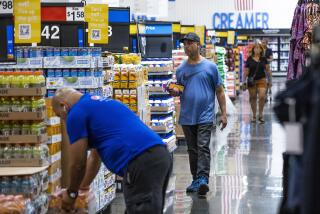Industrial Output Falls Again in July
- Share via
WASHINGTON — The combination of the Asian crisis and the General Motors Corp. strikes pounded the nation’s industrial production for the worst two-month decline since the start of the 1990-91 recession, according to government figures released Friday.
On the bright side, weakness spilling from Asia helped keep a lid on prices charged by factories and other producers. The producer price index of finished goods rose a modest 0.2% to 130.7 in July, driven by a drought-induced jump in vegetable prices, the Labor Department said.
“With Asia down for the count and much of the rest of the world wobbling, this comes as no surprise,” said economist Oscar Gonzalez of John Hancock in Boston. “This means U.S. consumers will continue to benefit from low inflation.”
The industrial production index, which measures the output of the nation’s factories, mines and utilities, fell a seasonally adjusted 0.6% to 126.8 last month, on top of a 1.1% plunge in June, the Federal Reserve Board said. It was the largest two-month drop since November-December 1990.
In this case, much--though certainly not all--of the weakness was temporary. GM strikes idling more than 190,000 workers began early in June and ended late in July. Motor vehicle output dropped from an annual rate of 12.4 million in May to 8.3 million in July.
But even excluding autos, industrial production would have edged up only 0.1% in July after declining 0.4% in June.
A third factor depressing production is a buildup in inventories of unsold goods early in the year. So, companies in the spring and summer have produced far fewer goods for inventory.
Reflecting that, the Commerce Department said business inventories rose 0.1% in June after no change in May. Automobile inventories fell 3%, the largest drop since 1991.
Fear that spillover from Asia will curb growth in corporate profits is worrying stock investors, but the silver lining is muted inflation.
Even with July’s small seasonally adjusted increase, the producer price index fell at a 0.3% annual rate during the first seven months of the year.
Last month, food prices rose a brisk 0.4% and energy prices, 0.3%. Excluding those two volatile categories, prices edged only 0.1% higher.
Drought in the South parched vegetable crops and their price jumped 21.3%, the largest rise in 16 months.
Meat prices also declined. Beef edged 0.1% lower, but pork prices plummeted 10.9%, the largest drop in 22 years.
Energy prices rose a moderate 0.3%, despite a 1.3% drop in the cost of gasoline. The increases came in residential electricity, 1.1%, and residential natural gas, 0.4%.
Prices outside food and energy would have been unchanged if not for a 1.7% rise in prescription drug prices. They were up 22.3% for the 12 months ended July. That was being skewed, the Labor Department said, by “changes by a small number of producers for a small number of individual drugs.”
Passenger car prices rose 0.8% in July as dealers ended discount programs. For the year, though, they’re up just 0.2%. Computer prices, down 1.6% for the month, continued their decline. Tobacco costs were unchanged after rising steeply earlier in the year.
* STATE JOB GROWTH ENDS: California’s nonfarm employment declines in July, the first drop in more than two years. A1
(BEGIN TEXT OF INFOBOX / INFOGRAPHIC)
Industrial Production
Index; 1992=100; seasonally adjusted:
July: 126.8
Source: Federal Reserve Board
Producer Prices
Index of finished goods prices; 1982=100; seasonally adjusted:
July: 130.7
Source: Bureau of Labor Statistics
More to Read
Inside the business of entertainment
The Wide Shot brings you news, analysis and insights on everything from streaming wars to production — and what it all means for the future.
You may occasionally receive promotional content from the Los Angeles Times.










